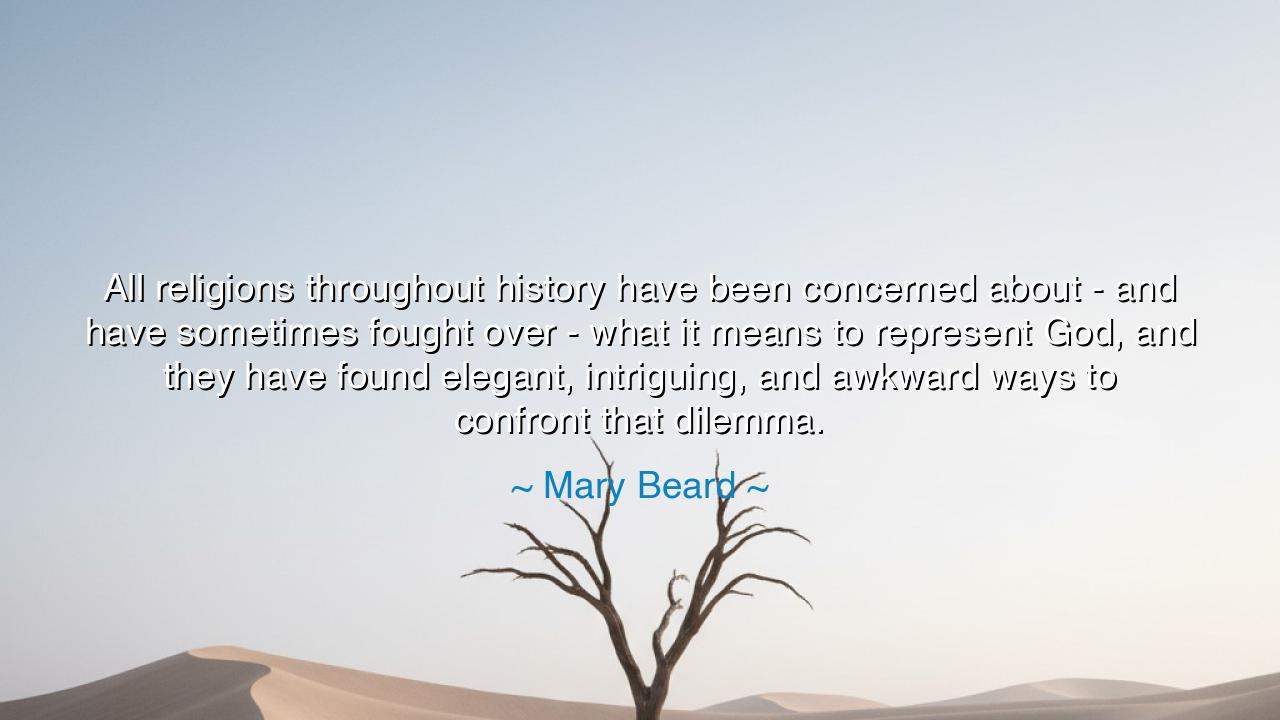
All religions throughout history have been concerned about - and
All religions throughout history have been concerned about - and have sometimes fought over - what it means to represent God, and they have found elegant, intriguing, and awkward ways to confront that dilemma.






“All religions throughout history have been concerned about – and have sometimes fought over – what it means to represent God, and they have found elegant, intriguing, and awkward ways to confront that dilemma.” Thus spoke Mary Beard, historian of empires and sculptor of memory, whose gaze pierces through the veils of time to uncover the struggles of faith and form. Her words reveal one of the oldest and most sacred tensions of humanity—the question of representation, the desire to make the divine visible without diminishing its mystery. For across ages and nations, mankind has reached upward, seeking to embody the unseen in image, in word, in temple, and in ritual. Yet with every attempt to portray the infinite, we brush against the boundaries of our own frail understanding.
From the dawn of civilization, this dilemma of representation has both inspired beauty and unleashed conflict. The ancients built idols and altars, mosaics and cathedrals—not from arrogance, but from longing. They wished to touch eternity with mortal hands, to fix the divine within the finite. Yet every image, however noble, risked betrayal of its subject. For how can the formless be given form without distortion? Thus arose the fierce debates that scarred the histories of faith—the iconoclasts and iconophiles of Byzantium, who battled over whether images of Christ were sacred conduits or blasphemous prisons. What began as devotion became division, and empires trembled over the simple question: How shall we represent God?
Consider the ancient Hebrews, whose prophets forbade the carving of graven images. Their God, invisible and infinite, could not be confined to wood or stone. In their restraint lay reverence, yet even in that absence, art found a way. The Tabernacle gleamed with gold, the Ark was adorned with cherubim—the unseen made known through symbol, not likeness. Contrast this with the Greeks, whose temples housed gods of marble and bronze, radiant in human form. To them, beauty itself was divine; to shape the body perfectly was to honor the divine ideal. Thus, two civilizations stood upon the same question and gave opposite answers—one worshipping the invisible, the other sanctifying the visible. Both sought truth; both revealed the limits of the human mind before the mystery of the divine.
In every age, this struggle has been renewed. When the Renaissance dawned, the brush of Michelangelo painted the finger of God reaching toward man, and the ceiling of the Sistine Chapel became a bridge between heaven and earth. Yet even then, some cried that art had gone too far, that to depict the Almighty in the image of man was pride. Still others saw in that image the greatest act of love—that God, unseen, might dwell in the lines of human creation. Such is the paradox Mary Beard evokes: that religion, though it seeks the eternal, must always wrestle with the mortal means by which it speaks.
The “elegant, intriguing, and awkward ways” of confronting this dilemma are the many faces of humanity’s yearning. From the geometric grace of the Islamic mosque, where no face of God is shown but His presence is felt in the perfection of pattern, to the serene smile of the Buddha, carved in silent compassion, each culture answers the same divine riddle in its own tongue. These are not contradictions, but echoes in a grand chorus of searching. For in every attempt to represent the divine—whether in image or in silence—we reveal something of ourselves, our fears, our hopes, our hunger for transcendence.
Yet Beard’s wisdom also bears a warning: that this sacred struggle can turn violent when pride overshadows wonder. When men begin to believe that their vision of God is the only true one, they cease to worship the divine and begin to worship their own reflection. History’s wars of religion, its persecutions and burnings, are born not from faith, but from the arrogance of certainty. The divine is vast enough to contain both the painter and the prophet, both the cathedral and the empty shrine. To deny that diversity is to deny the very mystery that gives faith its power.
Therefore, let us learn from Beard’s insight: to approach the divine not with rivalry, but with reverence. When you behold a work of faith—be it a temple or a poem—see in it not an error of doctrine, but an expression of longing, a human attempt to make peace with the infinite. Understand that every symbol is but a shadow, and yet, in its imperfection, it shines. The wise do not destroy the image nor worship it blindly; they contemplate it, letting it lead them inward toward the ineffable truth it reflects.
And so, children of the future, take this teaching to heart: do not fear the many faces of the divine. Whether through word, image, silence, or design, each is a mirror reflecting a fragment of eternity. Mary Beard’s words remind us that the story of God’s representation is the story of humanity itself—a story of struggle, beauty, and humility. Let us, then, create not to claim the divine, but to honor it; not to define heaven, but to celebrate the mystery that forever lies beyond our reach. For it is in that tension—between what can be shown and what cannot—that the true soul of faith resides.






AAdministratorAdministrator
Welcome, honored guests. Please leave a comment, we will respond soon